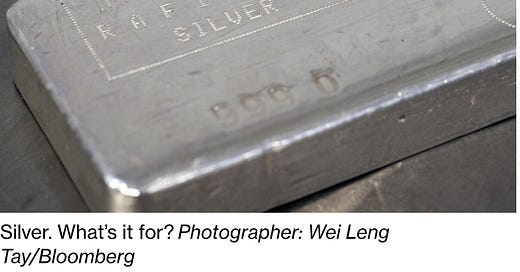Housekeeping: Not Analysis. Likely testing the waters for more substantive pieces.
The Case for Investing in Silver (Carefully)
Gold’s more volatile sibling is a unique mix of industrial and monetary metal.
March 25, 2024 at 1:12 PM UTC
Should you invest in silver?
I want to take a look at something a bit different this morning. Silver.
Silver is an intriguing metal. Like gold, it’s a precious metal often used in jewelery. But unlike gold, it has a vast array of industrial uses, from solar panels to computing to health. That means its price is influenced by economic growth prospects. A booming, or recovering, economy will generally be good for silver.
More interestingly still, more silver is being used each year than is being dug out of the ground, according to a recent note by Michael Hsueh at Deutsche Bank. In other words, it’s running at a supply deficit. That sounds quite exciting — more demand than supply.
But there’s a catch. As Hsueh notes, there’s still a “vast stock of silver above ground” in the form of scrap silver that could easily make its way to market at the right price. As a result, physical supply and demand is not an issue in the way that it can be for, say, oil.
Big yawn at silver then? Not quite. You see, in common with gold, yet unlike any other precious metal (eg platinum and palladium), silver used to play a role — albeit a junior one — in the monetary system. As a result, it’s not just the economic cycle that matters, but also the monetary backdrop.
Put more simply, silver tends to follow what gold is doing. And based on the gold/silver ratio, silver is currently on the cheap side by that measure, notes Charlie Morris over at ByteTree. Today, as the chart below shows, one ounce of gold will buy you roughly 88 ounces of silver. The 30-year average is more like 67.
The ratio can, of course, correct in more than one way. Both the gold and silver prices could fall — the ratio could still drop as long as the gold price falls faster than that of silver. Hsueh at Deutsche Bank reckons that both prices overall are likely to range trade in the coming months, rather than move strongly in either direction.
But assuming you think gold’s bull market can be sustained in the longer run (as my colleague Marcus does) — and particularly if you think that there’s a chance that the global manufacturing cycle might be about to turn higher — there’s a case for arguing that silver may have further to go.
So how should you think about silver from an investment point of view?
How to Invest in Silver
For me, the key difference between gold and silver boils down to this: gold is basically always worth having in your portfolio as a form of disaster insurance. Loosely speaking, while gold is volatile, it tends to behave differently to any other asset class. So it has a role as a core (if small) diversifier in your overall asset allocation.
Silver, on the other hand, is optional. If gold is going up, silver will tend to go up too. Depending on the starting point and the economic backdrop, it may well go up faster than gold. But it’s highly volatile — it will give you a serious rollercoaster ride.
So in my view — unless you really think that hyperinflation and fiat collapse is on the cards, and you’re happy to wait faithfully for that moment when the silver price presumably goes to infinity and beyond as a result — it’s more of a trade. In turn, that means that if you do decide to invest in it, you should have a plan for when you’ll sell.
If you are interested in owning physical silver, you can go for the romantic option and buy antique silver, or buy it in bullion or coin form. One irritation for UK investors is that unlike gold bullion, silver bullion coins or bars are both subject to VAT at 20%.
If you’re just looking to get exposure, it’s easier and cheaper to buy via an exchange-traded product backed by physical silver (there are plenty of options for investors across the UK, Europe and the US), or via one of the online bullion dealers that will put your name on a lump of silver in a warehouse.
Another option is to invest in precious metals miners. Again there are a range of funds — from actively-managed to passive exchange-traded funds — you can use for this purpose (though you won’t get a silver pure-play because it’s largely a by-product of mining for other metals).
Similarly to silver, precious metals miners are volatile and their historic track record has been poor. That said, the sector is cheap relative to both history and to the gold price.
As Duncan MacInnes of asset manager Ruffer pointed out in a recent blog post, “US listed miners have a combined market cap of some $250 billion, around the same as Nvidia rose in one day the last time it reported earnings.”
If investors decide that the gold bull market has legs, then it’s very possible that both silver and the miners could benefit from the dash for catch-up trades. As always though, do your own research, consider how any new additions fit with your existing portfolio, and be aware that these are higher-maintenance investments than a standard equity tracker fund.
Send any feedback, opinions or questions to jstepek2@bloomberg.net and I’ll print the best. If you were forwarded this email by a friend or colleague, subscribe here to get your own copy.
ING Commodities Commentary:





